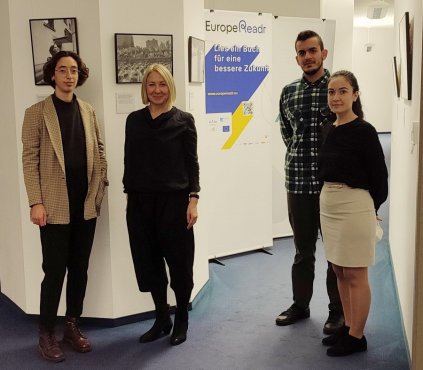An interview with the Head of SKICA, the Slovenian Cultural Centre in Berlin, Saša Šavel Burkart
“Thinking of cultural diplomacy, a few notions come to my mind: connect, exchange, strengthening, bridging, and participating in the cosmopolitan nature of Europe”
October 15th, 2021You have been Head of the Slovenian Cultural Center since January 2021, how would you describe your experience so far? What have been the main challenges?
I have been a journalist in the field of culture and contemporary art for 25 years, and I think that art itself can defined as cultural diplomacy. It bears this role and we are agents in this process of building bridges and relationships through art. The role of a journalist is very much similar: to represent and show something to an audience. A major challenge I faced with this switch of roles is that you are no longer an observer or simply a teller, but you are an active participant in the representation and promotion of Slovenian culture and arts abroad.
It is important for us to build bridges with Germany and promote our excellent Slovenian art and culture isn’t that well known here, although Slovenian and German culture have many intersections.
We can do so also with the help of partners and the creation of a shared network for creating projects together. This has been a big challenge actually. We are a small cultural centre and don’t have our own space, so it was necessary to find partners that allow you to be part of a project and reach the local audience. I arrived in January and I had to find partners and make a program for this year. It was very successful, maybe also because of the pandemic. Some of them were Literaturhaus Berlin, Haus für Poesie, Kino Arsenal. In the frame of Berlin Design Week, for example, we had an exhibition of contemporary Slovenian design called "The Future of Living" in the frames of the EU Council Presidency. The key to reaching the local audience is finding partners, otherwise, you wouldn’t be able to reach the local community. Of course, there is a small Slovenian community in Berlin which consists of around 4000 Slovenians, and they participate in our projects. But our main goal is not to create projects for the Slovenian audience but to connect to local partners and local audiences.
What are the main priorities of the Slovenian cultural centre in Germany?
My priorities this year were to cooperate with the Ministry of Foreign Affairs to implement some projects. Among them, there was Future of Living as I mentioned, there is Europe Reader, which is in the frames of EUNIC Global, a digital library. By scanning a QR code you can get access to 27 digital books, one for each European country.
These two projects were the main priorities for this year. Furthermore, this year we celebrate 30 years of Slovenian independence. We decided amongst other to celebrate the Slovenian lace from Idrija. We did this through the art installation that consists from lace in collaboration with St. Marienkirche on Alexanderplatz which is a very important protestant church in Berlin. The priest there is Pfarrerin Zisselsberger, she is very liberal and hosts many ecumenic projects. She was happy to host a huge lace installation of 55sqmn from the Slovenian artist Eva Petric, the ‘COLLECTIVE HEART’, collected the lace practice from Idrija women and wanted to tell their stories, organizing exhibitions of these art installation from Vienna, to New York and Berlin.
Moreover, in the next four years, we want to bring at least two big projects, exhibitions, from Slovenia to Germany. We also hope to successfully bring Slovenian impressionists here. Many of them had connections in Munich and Bavaria. One of them, Anton Ažbe, had a school there where many famous painters studied. This is an example of how we like to deal with Slovenian-German cultural crossroads. Also, we would like to present a bigger contemporary art exhibition from Slovenia in Germany and an exhibition of a very interesting woman, a writer Alma Karlin, who travelled around the world and wrote in German. We have a big community of hybrid arts that intersect with science and are renowed.
The last thing I want to emphasize is the biggest priority at the moment: to prepare for Frankfurt 2023 where Slovenia is going to be the guest of honour of the Buchmesse.
Can you tell us what Cultural Diplomacy means to you? How can it strengthen the relationship between Slovenia and Germany?
Thinking of cultural diplomacy, a few notions come to my mind: connect, exchange, strengthen, bridging, and participating in the cosmopolitan nature of Europe.
How did the pandemic affect the cultural centre? Did you learn or benefit from anything during this period that will be carried out in the future?
In some ways, the fact that everything was still was helpful: for example, some partners were glad that someone was reaching out and trying to organize something in the hope that the situation would get better in the future. We also had more time to sit in front of the computer and evaluate offers and projects.
So on one side, it was a productive period but on the other side, it was also problematic: meeting people only through a screen was really hard and it is not the same as meeting in person. It would not have been the same to have this interview through a screen. Maybe you could have misinterpreted something. When you meet someone in person it is easier to connect and understand each other. As a matter of fact, personal connections and exchange are crucial to cultural diplomacy too.
I also learned a lot about how much we must cherish live cultural events: meeting people, being able to feel, smell and experience museums, theatres and exhibitions. Without this personal and empirical experience, it’s difficult to have actual cultural diplomacy or intercultural dialogue.


